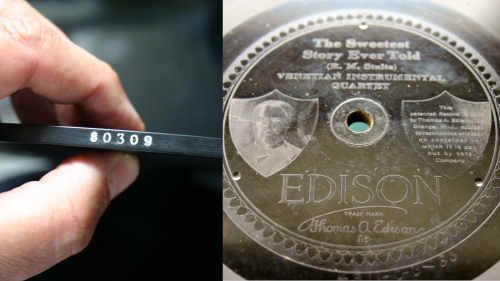A 365-Day Project
"We Are All Mozart"
A project to create
new works and change
the perception of the
music of our time.


 July 28, 2006
July 28, 2006 
Formats are amazing. Who can keep up? And I don't even grasp the new ones!
No, this is not a music day. This is a semi-tech day. One of my interests is restoring old recordings -- mostly family recordings or one-of-a-kind concerts. Over the past century, there have been so many ways to record that the formats have piled up and equipment to play them has ceased to exist. If you're not a tech person, read along anyway. It's a surprising story of development and change and stress that's gone on for more than a hundred years.
We think back on 78-rpm records as a kind of class of breakable, black shellac discs with lots of scratches and poor, indistinguisable sounds. But in fact they were an amazing, evolving technology. In the pre-electrical days, soloists and ensembles would play into columns of "morning glory" horns that would funnel the sound to a cutting blade. From this cut master would be produced a stamper to create more copies -- quite an improvement over the cylinder days, when small lots were produced individually (you can't stamp out a cylinder) and the musicians would play a song over and over to make each batch of cylinders.
These 78's (which, before electric motors, varied in speed) sound quite good when played on an original Victrola, for example. I had an oak Victor VV-VI ca. 1910 that was my great-grandfather's, and its speed governor used three brass half-spheres on spring steel bands attached to rotors. Under pressure of the wind-up mainspring, they would spin quickly, the bands stretching to give them more speed until the rotors made contact with a stop attached to a speed-adjustment knob. So the speed on the VV-VI could be varied from between about 40 and 120 rpm, and platter rotation was stopped by a simple leather brake on a lever that pressed against the inside edge of the platter. The unit did not use an above-arm "morning glory" horn as early phonographs had, but a sound amplifying box that was part of the cabinet. This lent a warm and less edgy sound
The progress of the spinning disc is remarkable, from the latter days of the 19th century through its effective demise a hundred years later. Early mass-produced records were heavy, single-sided affairs that cost $1 or more, and manufacturers quickly became engaged in format wars. Thomas Edison's eponymous company and Victor Talking Machine Company went head-to-head, with the former first producing cylinders using high-quality "hill-and-dale" (vertical) recording -- the sound moving the stylus up and down -- and then moving to flat hill-and-dale discs some years later. Victor produced flat discs from the beginning with side-to-side (lateral) recording, the familiar wavy groove licensed from Berliner. In the early days, one machine wouldn't play the other's recordings -- much like the subsequent 45/LP, Beta/VHS, CED/DVD, and Blu-Ray/HD-DVD format wars. By clever marketing with known personalities, Victor won that battle.
Electrification in the 1920s stabilized the speed and made possible microphone recordings -- though these records were sometimes acoustically dim until engineers experienced only with resonant horns could learn to express the music's performance with microphones. 10-, 12- and 16-inch platters were produced, the latter eventually reserved for radio stations. Portable recording devices were made which cut a plastic surface with grooves, sometimes down to a metal or glass base. Portable recordings resulted in an invaluable preservation of music from cultures across the world before they were influenced and deformed by recordings and radio.
At 78 rpm, even 12-inch platters weren't long enough. A Beethoven Missa Solemnis recording in my collection was cut at a live concert on two side-by-side lathes, and the microphone was flipped from one to the other at convenient points. There is no editing, no fading. It just stops at the end of a phrase (most of the time) on one 78 and starts again on the next platter. Early experiments with stereophonic sound used double-armed players, where one area of a record was reserved for each channel and separated by a wide blank band. Slower speeds were used on plastic transcription recordings destined for radio play.
By the 1940s, new materials produced 'unbreakable' 78s in a variety of colors. There was a Brahms first symphony in my collection that was stamped in transparent red plastic, dating from about 1949. The different grooves on each side made marvelous patterns in the light. As materials improved, so did sound quality. In fact, the scratchiness associated with 78s was largely a result of their repetitive playing, where steel needles had ripped up the groove walls. Few of the LP and CD generations have heard an unplayed 78, but pristine 'shellacs' as they were called have a sound almost as clean as LPs. Stampers for 78s have been taken out of vaults to produce individual vinyl copies for transfer to digital form. (The commercial remarketing of these vinyl 78s to audiophiles met with a timely end.)
The 1950s brought more format wars. 78s vanished for music (though 78s continued to be produced for children in colorful forms and as novelties) and two new plastic discs appeared: the large-hole 45-rpm record (from RCA) and the 10-inch record at 33-1/3 rpm (from Columbia). After some bitterness (and even the claim by RCA that people were too used to the old format of one song per side, and the issuance of entire classical symphonic works on a stack of big-hole 45s!), the 45s become the format for singles and the long-playing records (the LPs) became the standard for albums (a term left over from the 78 days when an album of records by a single artist or of a longer classical composition could be purchased). Special slow speeds of 16-2/3 and 8-1/3 rpm were later developed for talking books.
12-inch platters soon replaced 10-inch ones, and grooves got narrower so more music could be fit on a side. Various equalization schemes were used, because a needle would jump out of a groove if the bass was too loud and it would not pick up quite enough high frequency to sound convincing because it was, after all, just a needle scraping across plastic. Early amplifiers had knobs to switch equalization schemes, but eventually the Recording Industry Association of America (the very same RIAA that acts as a marketing monolith today) equalization curve was standardized; low frequencies were reduced and high frequencies boosted during mastering, and the process reversed by the listener's phono preamplifier, resulting (ideally) is a convincing recreation of the original recording.
Stereo appeared in the late 1950s, and the very idea of producing two channels from a single plastic groove was a technological marvel. The familiar side-to-side (lateral) motion was combined with Edison's old hill-and-dale (vertical) motion and the combined pair effectively turned 45 degrees to one side to create a variable-wall groove, each wall containing one channel. Despite the absurdity of the idea of bouncing a needle in two different directions, it actually worked. Stereo took off.
Spinning discs were refined until the 1980s, when demand slackened. The final purity of vinyl expressed the end of a noble format, even if it was maintained for a while in niche markets and for the turntable artists (who now can sample from CD libraries on special turntable-emulation devices).
Mid-century also brought a truly explosive growth in recording in the studio and at home. Wire recorders had been used for dictation before 1950, but the development of flexible, cuttable, magnetic oxide tape (an early recording of, yes, Mozart was produced in Berlin in 1936, and its reissue is part of my collection) improved fidelity and made possible editing outside of real time, as well as multiple channels on a single strip of moving tape. By the time tape reached the U.S. in the late 1940s, it was instantly adopted.
And here the story gets interesting, confusing, and even maddening for anyone restoring old recordings.
Tape sizes and speeds proliferated, from 15 inches per second (ips) down to 15/16 ips; each speed had a separate equalization setting to get the most even recording response for the speed and tape formulation. Tape widths ran from initial 1/4-inch tape up through 2-inch-wide professional tape for studios. Reels were 10 inches in diameter, but as taping reached the consumer level, sizes fell to 7-inch, 5-inch and even 3-inch reels for portable transistorized machines. Tape was 2-mil thick paper or acetate, eventually switching to tensilized Mylar at 1 mil down to as thin as 1/4 mil, a home-recording thickness sold on 3-inch reels that was subject to tangling and crumpling. Old acetate tape is fragile and because it is made from natural materials, is subject to moisture warping, mold, mildew and being eaten by critters.
Tape was initially recorded in one direction across the full face of the tape (I have some "Bell Telephone Hour" and "Band of America" recordings in my collection in superb fidelity at 15ips mono), then split into two parallel tracks for stereo. Home machines could flip the tape reels, running tape backwards to create two mono tracks instead of stereo, and home stereo later interleaved four tracks, two in each direction. Quadrisonic recording in the 1970s used the full width of the tape moving in one direction. One could find endless-loop reels of tape for advertising purposes. And this was all just reels! (You can hear some examples of restoration here -- and the sound of paper tape from 1949 is remarkable. There are also photos of various disc recordings.)
The advent of convenience formats in the 1960s included the bulky and short-lived Elcaset, the 8-track (an endless loop of tape containing four stereo tracks moving in one direction, the tracks switched by moving the playback head up and down on a ratchet) and the compact cassette (one track in each direction, later splittable into stereo, but not interleaved like reel-to-reel stereo). There were secretarial formats such as dictabelts and dictation cards and later portable recorders from Sharp with the special tape cartridge that snapped onto the top end-- plus minicassettes and microcassettes and answering machine tape belts.
Once the Philips patents expired, Tascam and Fostex created four forward tracks on a cassette for home recording studios. Tape formulations had always used ordinary iron oxide, but the slow speed of cassettes (1-7/8 ips) demanded higher quality. Type II (chromium) and Type IV (metal) cassettes appeared. But that's not all! Playing back tape produced a noticeable hissing sound, so engineers sought solutions, the most familiar being Dolby A (professional) and B and C (both home) and dbx I (professional) and II (home). Yes, even dbx LPs were produced just before the CD overwhelmed vinyl! And cassette improvements also influenced the quality reel-to-reel tape, which subsequently appeared in Type II and IV oxides as well.
A huge tape formulation mistake made by Ampex and others in the 1980s was a disaster for both studio masters and home recordings. After ten to fifteen years, the chemistry of the smooth combination of oxide and binder (the slurry) would change, causing the tape to turn into a sticky gum. Tapes would cake on heads and guides and bring a machine to a standstill. A careful process of tape-baking can restore the chemistry, but only for a few days -- long enough to copy the tape.
The digital era began with audio recording to videotape, PCM digital on Beta cassettes and also a pseudo-digital Beta HiFi or VHS HiFi. Soon digital audio tape (DAT) and digital cassettes (DCC) appeared, the latter dying quickly. Camcorders and decks recorded digitally, and the process continues today through hard-disk, direct-to-CD, and flashcard recording.
How many ways of recording and reproducing sound is that? How many have I left out?

Edison disc of The Sweetest Story Ever Told, with selection number edge showing its thickness.